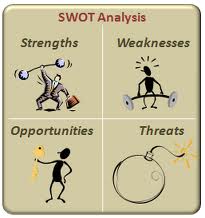 I’ve had SWOT on my mind a lot lately. For those of you who don’t know, this acronym is a planning term that stands for “Strengths-Weaknesses-Opportunities-Threats“. It is an exercise you go through during the assessment phase of whatever planning process you’re undertaking. If used correctly, it should provide you with a platform upon which to build your goals, objectives and action plans. Unfortunately, I see too many organizations “going through the motions” and under-utilizing this very powerful tool.
I’ve had SWOT on my mind a lot lately. For those of you who don’t know, this acronym is a planning term that stands for “Strengths-Weaknesses-Opportunities-Threats“. It is an exercise you go through during the assessment phase of whatever planning process you’re undertaking. If used correctly, it should provide you with a platform upon which to build your goals, objectives and action plans. Unfortunately, I see too many organizations “going through the motions” and under-utilizing this very powerful tool.
Not just for strategic planning
SWOT gets used a lot in strategic planning projects, but I see very few people employing this tool when working on a:
- board development plan
- marketing plan
- resource development plan
- individual giving campaign plan
- program plan
- facilities maintenance plan
- capital improvement plan
- business plan
Generally speaking, a SWOT analysis tells you what your organization has going for it and against it. From this perspective, wouldn’t you want to know this before rolling up your sleeves and undertaking any project?
Scrambling the letters
 There seems to be a genuine misunderstanding about the letters in this acronym. In my experience, people get confused and only use this exercise to look internally at their own organization. In reality, the SWOT exercise is designed to look both internally and externally.
There seems to be a genuine misunderstanding about the letters in this acronym. In my experience, people get confused and only use this exercise to look internally at their own organization. In reality, the SWOT exercise is designed to look both internally and externally.
The “S” and “W” stand for “Strengths” and “Weaknesses”. At this point in the exercise, participants should be inwardly focused on the following questions (as it pertains to the project you’re thinking about undertaking):
- What do we do well?
- What don’t we do so well?
The “O” and the “T” stand for “Opportunities” and “Threats”. At this point in the exercise, participants should be externally focused on the following questions (as it pertains to the project you’re thinking about undertaking):
- What’s happening or about to happen outside of our organization (or your department) that we can take advantage of to help make this project successful?
- What’s happening or about to happen outside of our organization (or your department) that we should be concerned about because it could negatively impact the success of this project?
In my experience, too many people don’t want to use the “O” and “T” to look external. For whatever reason, they like to remain focused internally and they conflate strengths and opportunities as well as weaknesses and threats.
I can’t tell you how many times I’ve seen a project run aground because of external factors that weren’t given any serious consideration during the planning process.
You want an example? Here you go . . .
Non-profit ABC decides to plan and implement an annual campaign pledge drive. They put together their campaign plan and their focus is 100% internal (e.g. staffing, volunteers, materials, reporting, systems, etc). They launch the campaign and quickly find out that donors (aka an external audience) don’t support the campaign for any number of reasons (e.g. not enough cultivation, not enough stewardship, etc).
Not following through
 One of the biggest mistakes I see when it comes to using a SWOT exercise is not following through and using the analysis. This happens when participants do the good work in assessing their internal strengths and weaknesses and the external opportunities and threats and then stop right there.
One of the biggest mistakes I see when it comes to using a SWOT exercise is not following through and using the analysis. This happens when participants do the good work in assessing their internal strengths and weaknesses and the external opportunities and threats and then stop right there.
At the end of any good SWOT exercise, the following questions need to be asked as you pivot toward goal setting:
- What strengths will help us implement this project?
- Are there specific strengths we should build our plan around?
- Which organizational weaknesses pose challenges to our plan?
- Should we build things into the plan that help us fix our weaknesses?
- If fixing our weaknesses isn’t realistic, are there things we should build into the plan to help us compensate for our weaknesses?
- Are there external opportunities we need to take advantage of to help us achieve what we want to achieve (e.g. low hanging fruit)?
- Are there external threats (e.g. icebergs in the water) that we should try to account for in the plan?
SWOT just for the sake of doing SWOT is meaningless. The information and insights you gain from this powerful exercise should be used as a springboard into goal setting conversations. These questions can act as a lens by which you look at your “vision” and brainstorm the goals for accomplishing your vision. You can do the same thing when pivoting toward development of objectives as well as when you finally pivot towards action planning. In each of these cases, SWOT acts as a lens by which you frame the next stage of the planning process and keep things real.
My simple suggestion is . . . get in the habit of using SWOT before tackling any large project and use this tool to its fullest extent. Doing so improves your planning process and increases the likelihood of future success.
Has you organization ever used SWOT for anything other than strategic planning? If so, how did it work for you? Please scroll down and share your experience in the comment box below. We can all learn from each other.
Here’s to your health!
Erik Anderson
Founder & President, The Healthy Non-Profit LLC
www.thehealthynonprofit.com
erik@thehealthynonprofit.com
http://twitter.com/#!/eanderson847
http://www.facebook.com/eanderson847
http://www.linkedin.com/in/erikanderson847

Thank you for this great post. I’ve only used SWOT in a small volunteer-based community organization. We used it to get an overall view of our actions and to set our goals. I never thought about using it for smaller projects, like putting together a marketing plan. That is a very good idea.
Always glad to help with an ah=ha moment, Molly. Thanks for your readership and taking a moment to comment! Perhaps, you will circle back after using SWOT on a smaller scale and share with readers how it worked for you. THANKS!!!
I use it often in the organisations I work with and find it interesting to get people to talk through the threats – which often turn into opportunities once the initial feeling of being victims of external forces passes. Some of the best ideas I’ve heard (and seen implemented) come from this realisation.
Thanks for your validation and encouragement, Liz. I hope we hear a lot more from you in the future at DonorDreams blog.